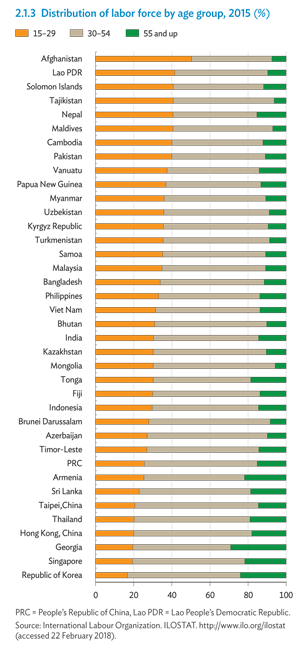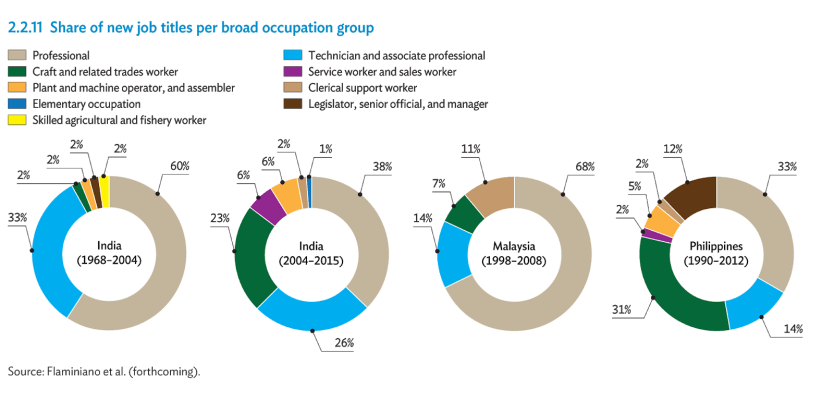
MANILA — Almost every industry talks about the potential of automation to boost productivity and cut down on production costs. But the new technologies spurring these incentives, such as robotics, are also posing threats — not just for unemployment, but also in widening the gap in worker opportunities and income inequality.

Developing Asia’s industry and services sectors have generated about 30 million jobs annually over the past 25 years, according to the Asian Development Bank’s flagship report, the Asian Development Outlook 2018. This is evidence of many countries’ expanding economies. But this isn’t and won’t be enough. From 2015 to 2030, jobs in Asia will need to further expand to accommodate 11 million more people projected to enter the labor market annually.
The challenges don’t stop there. The advent of technological advancements has the potential to reduce job opportunities.
In some sectors such as manufacturing, this is already happening. Many countries in Asia have increased the use of industrial robots when it comes to the manufacture of electrical and electronic goods, metals, plastics, and even in the auto industry.
As is the case in these industries, worker employment is at a low. The report shows the electronics and auto industries each accounted for 39 percent of robot stocks in the region, and yet worker employment was only at 9.2 percent and 4.2 percent, respectively.
Those working in the food and beverage sectors, as well as textiles, leather, and apparel, need not fret however, as data shows these industries still rely more on workers than robots — 0.1 percent robots versus 19.2 percent workers in textiles, leather, and apparel manufacturing, for example.
China is the largest market in Asia Pacific for industrial robots, accounting for 43 percent of all industrial robot sales in the region, followed by South Korea (24 percent) and Japan (22 percent). Almost 40 percent of the world’s industrial robots are projected to be in China by 2019, according to the International Federation of Robotics.
This trend isn’t entirely new. Over the course of history, industrial revolutions have disrupted employment. And while some jobs have been replaced by automation, new employment opportunities often emerge. This trend isn’t dissimilar to what’s currently happening under the so-called fourth industrial revolution.
For example, the introduction of robots in the production line could displace manual, repetitive jobs such as assemblers, but it could generate new jobs for programmers or those who need to tend to the machine.
But there is an emerging, worrying trend here, with highly skilled workers benefiting from automation, while low-skilled workers — most of whom have little education or opportunity to upskill — are being ejected from their jobs, finding fewer opportunities, or experiencing slow to minimal growth in their earnings.
“The extent that upgrading technology is skill-biased, it shifts demand from workers with lower skills to those with higher skills, widening inequality. This poses a problem for developing economies competitive in low- to medium-skill activities, as using advanced technology could create a shortage of high-skilled workers and surplus of medium- and low-skilled workers,” according to the report.
Based on an analysis of employment changes in 12 select economies in Asia, the report finds that most of the new job titles created through the introduction of technologies up to 2015 appear “primarily in professional categories.” In India, for example, 93 percent of all jobs generated from 1968-2004 by the advent of technology are in the professional sector, and most of them require the use of computers and ICT knowledge: software engineer, system programmer, database design analyst, computer system hardware analyst, computer quality assurance analyst, and computer security specialist. Between 2004 and 2015, job titles have also emerged in nonprofessional categories, but these continue to require some sort of knowledge on ICT — such as smartphone repair technicians or those installing solar panels.

And this trend seems likely to continue. ADB analyses of employment structure in India, Indonesia, the Philippines, Thailand, and Vietnam show a shift toward jobs that are non-routinary and more cognitive in nature, and require more social interaction and ICT skills. These jobs are seen as complementary to the automation processes taking place in industries, but they require more education and training.
Meanwhile, the labor market is moving away from manual jobs as these can easily be replaced by machines — but these are the jobs workers with basic education often acquire. Without sufficient upskilling — or necessary interventions from government for skills development, labor regulations, and social protection systems protecting workers’ incomes, and policies to ensure there’s enough government budget for all of the above — they could be left behind.
“The magnitude of these changes in the past decade or so is sizable, and the trend will likely persist. The major challenge for Asian economies is to cope with this structural transformation in the nature of jobs. If Asia’s workers are not given the skills in demand — particularly to fill jobs intensive in nonroutine and cognitive tasks — they may be left behind. Incomes for the few with the required skills will rise, exacerbating inequality,” finds the report.
